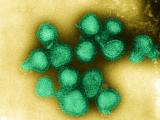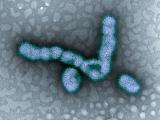Mar 24, 2010 (CIDRAP News) – Structural similarities between the pandemic flu viruses of 1918 and 2009 may explain older adults' apparent immunity to the newer virus, two scientific teams report today in two journals. Their results may also explain how pandemic viruses evolve into seasonal viruses, and could point the way toward development of future pandemic vaccines.
Writing in Science Express, the online ahead-of-print arm of the journal Science, Ian Wilson and Rui Xu of the Scripps Research Institute and colleagues from Vanderbilt University and Mount Sinai School of Medicine say that the 1918 and 2009 pandemic viruses are antigenically close, with hemagglutinin proteins that share similar crystalline structures. In contrast, the hemagglutinins in 24 seasonal flu strains dating from the 1930s through the 1950s, and 9 seasonal-vaccine strains from 1977 through 2007, differed from the pandemic strains by 30% to 58% of their amino-acid sequences.
The similarity between the two pandemic viruses is unusual, not only because they are separated by so many years, but also because genetic evidence has shown that the 2009 pandemic virus was not brand-new, but had already been circulating in humans—two circumstances that would have been expected to cause the viruses to diversify as they adapted.
The researchers said the unexpected similarity would have allowed the immune systems of those exposed to the 20th century virus to mount a defense against the 21st century one.
"Our findings provide strong evidence that exposure to earlier viruses has helped to provide some people with immunity to the recent influenza pandemic," Wilson, who is Scripps Research Professor, said in a statement.
A second study, published on the website of Science Translational Medicine, adds significant detail to the understanding of the ways in which the two pandemic viruses are like each other and unlike seasonal flu strains.
Through a combination of computer modeling and experimental work, scientists at the National Institutes of Health (NIH) and the Centers for Disease Control and Prevention (CDC) determined that seasonal viruses possess, and the pandemic viruses lacked, a cap or covering of sugar molecules on the head of each organism's hemagglutinin.
Flu viruses acquire those sugars or glycans as a defense against the neutralizing antibodies produced by the human immune system. Among flu strains that circulated between 1977 and 2008, the researchers said, 97.8% had at least one glycan molecule attached to the virus's spike protein, which allows it to infect cells, while 87.8% had two glycan molecules.
But because the 1918 and 2009 pandemic viruses lacked any glycan protection, they were cross-vulnerable to antibodies stimulated in mice by exposure to either virus. When mice were vaccinated with either virus, the 2009 pandemic H1N1 or the reconstructed 1918 H1N1, they developed cross-reactive protection against the other virus as well.
"This is a surprising result," co-author Dr. Gary J. Nabel of NIH's National Institute of Allergy and Infectious Diseases said in a statement. "We wouldn't have expected that cross-reactive antibodies would be generated against viruses separated by so many years."
Through modeling, the researchers found that the 1918 virus would have acquired its glycan additions by the 1940s, illuminating the process and timeline by which a new pandemic virus becomes a milder and more persistent seasonal strain.
In a final experiment, the NIH and CDC researchers added glycan molecules to a 1918 virus, and used it as a vaccine in mice, which they then exposed to the "sugar-free" original 1918 strain. The altered virus conferred protection from the 1918 virus by stimulating the production of antibodies to which the original virus, lacking the sugar shield of later years, was vulnerable.
The researchers suggested that manipulating newly emerged viruses in such a manner could allow for the development of vaccines against future pandemic strains. If such vaccines were deployed, they said, the antibody protection produced could prevent a novel pandemic strain from becoming entrenched enough to evolve into a persistent seasonal flu.
Xu R, Ekiert DC, Krause JC et al. Structural basis of pre-existing immunity to the 2009 H1N1 pandemic influenza virus. Science Express 2010 Mar 24 [Abstract]
Wei C-J, Boyington JC, Dai K et al. Cross-neutralization of 1918 and 2009 influenza viruses: role of glycans in viral evolution and vaccine design. Science Translational Med2010 Mar 24 [Abstract]
See also:
Mar 24 National Institutes of Health press release
http://www.niaid.nih.gov/news/newsreleases/2010/Pages/pandemicflusugar.aspx


















